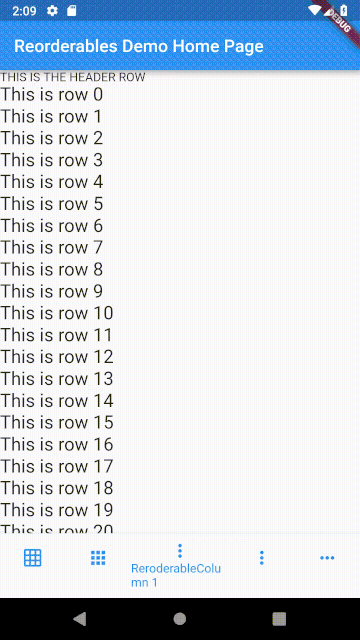reorderables 0.1.6  reorderables: ^0.1.6 copied to clipboard
reorderables: ^0.1.6 copied to clipboard
Reorderable table, row, column, and wrap that allow drag and drop of the children.
reorderables #
Various reorderable, a.k.a. drag and drop, Flutter widgets, including reorderable table, row, column, and wrap, that handle reordering the children within the widget. Parent widget only need to provide a function that is invoked with the old and new indexes of child being reordered.
Usage #
To use this package, add reorderables as a dependency in your pubspec.yaml file.
dependencies:
reorderables:
And import the package in your code.
import 'package:reorderables/reorderables.dart';
Examples #
This package includes ReorderableTable, ReorderableWrap, ReorderableRow, and ReorderableColumn, which are reorderable versions of Flutter's Table, Wrap, Row, and Column respectively.





ReorderableTable #
The difference between table and list is that cells in a table are horizontally aligned, whereas in a list, each item can have children but they are not aligned with children in another item.
Making a row draggable requires cells to be contained in a single widget. This isn't achievable with Table or GridView widget since their children are laid out as cells of widget instead of rows of widget.
class _TableExampleState extends State<TableExample> {
List<ReorderableTableRow> _itemRows;
@override
void initState() {
super.initState();
var data = [
['Alex', 'D', 'B+', 'AA', ''],
['Bob', 'AAAAA+', '', 'B', ''],
['Cindy', '', 'To Be Confirmed', '', ''],
['Duke', 'C-', '', 'Failed', ''],
['Ellenina', 'C', 'B', 'A', 'A'],
['Floral', '', 'BBB', 'A', 'A'],
];
Widget _textWithPadding(String text) {
return Padding(
padding: EdgeInsets.symmetric(vertical: 4),
child: Text(text, textScaleFactor: 1.1),
);
}
_itemRows = data.map((row) {
return ReorderableTableRow(
//a key must be specified for each row
key: ObjectKey(row),
mainAxisSize: MainAxisSize.max,
mainAxisAlignment: MainAxisAlignment.spaceBetween,
children: <Widget>[
_textWithPadding('${row[0]}'),
_textWithPadding('${row[1]}'),
_textWithPadding('${row[2]}'),
_textWithPadding('${row[3]}'),
// Text('${row[4]}'),
],
);
}).toList();
}
@override
Widget build(BuildContext context) {
var headerRow = ReorderableTableRow(
mainAxisSize: MainAxisSize.max,
mainAxisAlignment: MainAxisAlignment.spaceBetween,
children: [
Text('Name', textScaleFactor: 1.5),
Text('Math', textScaleFactor: 1.5),
Text('Science', textScaleFactor: 1.5),
Text('Physics', textScaleFactor: 1.5),
Text('Sports', textScaleFactor: 1.5)
]
);
void _onReorder(int oldIndex, int newIndex) {
setState(() {
ReorderableTableRow row = _itemRows.removeAt(oldIndex);
_itemRows.insert(newIndex, row);
});
}
return ReorderableTable(
header: headerRow,
children: _itemRows,
onReorder: _onReorder,
);
}
}
In a table, cells in each row are aligned on column basis with cells in other rows, whereas cells in a row of a list view don't align with other rows.
ReorderableTable Demo

ReorderableWrap #
This widget can also limit the minimum and maximum amount of children in each run, on top of the size-based policy in Wrap's algorithm. See API references for more details.
class _WrapExampleState extends State<WrapExample> {
final double _iconSize = 90;
List<Widget> _tiles;
@override
void initState() {
super.initState();
_tiles = <Widget>[
Icon(Icons.filter_1, key: ValueKey(1), size: _iconSize),
Icon(Icons.filter_2, key: ValueKey(2), size: _iconSize),
Icon(Icons.filter_3, key: ValueKey(3), size: _iconSize),
Icon(Icons.filter_4, key: ValueKey(4), size: _iconSize),
Icon(Icons.filter_5, key: ValueKey(5), size: _iconSize),
Icon(Icons.filter_6, key: ValueKey(6), size: _iconSize),
Icon(Icons.filter_7, key: ValueKey(7), size: _iconSize),
Icon(Icons.filter_8, key: ValueKey(8), size: _iconSize),
Icon(Icons.filter_9, key: ValueKey(9), size: _iconSize),
];
}
@override
Widget build(BuildContext context) {
void _onReorder(int oldIndex, int newIndex) {
setState(() {
Widget row = _tiles.removeAt(oldIndex);
_tiles.insert(newIndex, row);
});
}
return ReorderableWrap(
spacing: 8.0,
runSpacing: 4.0,
padding: const EdgeInsets.all(8),
children: _tiles,
onReorder: _onReorder
);
}
}
ReorderableWrap Demo

ReorderableColumn example #1 #
class _ColumnExample1State extends State<ColumnExample1> {
List<Widget> _rows;
@override
void initState() {
super.initState();
_rows = List<Widget>.generate(50,
(int index) => Text('This is row $index', key: ValueKey(index), textScaleFactor: 1.5)
);
}
@override
Widget build(BuildContext context) {
void _onReorder(int oldIndex, int newIndex) {
setState(() {
Widget row = _rows.removeAt(oldIndex);
_rows.insert(newIndex, row);
});
}
return ReorderableColumn(
header: Text('THIS IS THE HEADER ROW'),
footer: Text('THIS IS THE FOOTER ROW'),
crossAxisAlignment: CrossAxisAlignment.start,
children: _rows,
onReorder: _onReorder,
);
}
}
ReorderableColumn example #1 Demo

ReorderableColumn example #2 #
class _ColumnExample2State extends State<ColumnExample2> {
List<Widget> _rows;
@override
void initState() {
super.initState();
_rows = List<Widget>.generate(10,
(int index) => Text('This is row $index', key: ValueKey(index), textScaleFactor: 1.5)
);
}
@override
Widget build(BuildContext context) {
void _onReorder(int oldIndex, int newIndex) {
setState(() {
Widget row = _rows.removeAt(oldIndex);
_rows.insert(newIndex, row);
});
}
Widget reorderableColumn = IntrinsicWidth(
child: ReorderableColumn(
header: Text('List-like view but supports IntrinsicWidth'),
// crossAxisAlignment: CrossAxisAlignment.start,
children: _rows,
onReorder: _onReorder,
)
);
return Transform(
transform: Matrix4.rotationZ(0),
alignment: FractionalOffset.topLeft,
child: Material(
child: Card(child: reorderableColumn),
elevation: 6.0,
color: Colors.transparent,
borderRadius: BorderRadius.zero,
),
);
}
}
ReorderableColumn example #2 Demo

ReorderableRow #
See exmaple/lib/row_example.dart
ReorderableRow Demo

Support #
If you like my work, you can support me by buying me a coffee or donate me via PayPal. Your support is very much appreciated. :)


